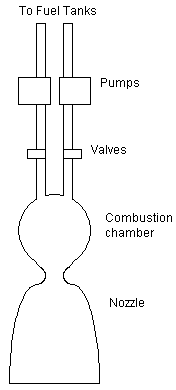Liquid Fuel Systems
Liquid Fuel rocket propulsion systems are much more complex than Solid fuel systems. The first Liquid propelant rocket system was tested in 1926 by Robert Goddard. He also solved several other problems with rocket engine design, such as pumping mechanisms, searing arrangements and cooling strategies. It is these problems that make Liquid fuel propulsion systems so complicated.
In the most basic sense, A liquid fuel rocket works by pumping a fuel (such as gasoline) and an oxidizer (such as Liquid Oxygen) into a combustion chamber. There, the fuel is ignited creating a High-presure and High-velocity stream of gases. These gases are then directed through a nozzle that accelerates them even further. A much simplified diagram of such an engine is shown bellow.

Image courtesy of www.howthingswork.com
This description does not even come close to describing the true complexities of a Liquid propulsion system. In order to overcome the high pressures created in the combustion chamber when the fuel is ignited, the pumps have to be very powerfull. It is common for one or both of the substances used as fuel to be a cold liquefied gas. In order to counteract the large amounts of heat produced in the combustion chamber, the gases are often circulated around the combustion chamber before being pumped in. A real Liquid propulsion system can get very complicated. For an example of just how complicated, go here
There are various types of fuel commonly used in Liquid Propulsion systems. For example:
- Liquid hydrogen and liquid oxygen. This combination is currently used in the space shuttles main engines
- Gasoline and liquid oxygen - used in Goddard's early rockets
- Kerosene and liquid oxygen - used on the first stage of the large Saturn V boosters in the Apollo program
- Alcohol and Liquid Oxygen - used in the German V2 rockets
- Nitrogen tetroxide (NTO)/monomethyl hydrazine (MMH) - used in the Cassini engines
Liquid propulsion rockets have many advantages over solid propulsion systems. You can control the amount of thrust by regulating the flow of the fuel and oxidizer to the combustion chamber. You can stop and restart the engines by simple stopping the flow of fuel and restarting it. However, as was mentioned previously, Liquid systems are horrendously complicated and expensive. In addition, they are not as safe, since if you mix too much of the components an explosion could easily result. As a result, liquid propulsion systems are generally not used in situations where solid rocket boosters can suffice.
